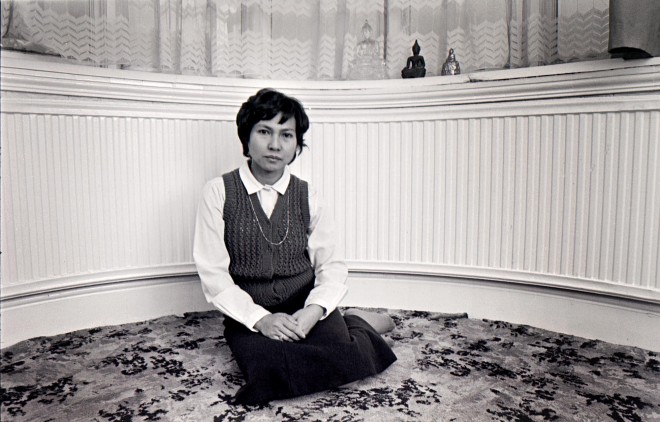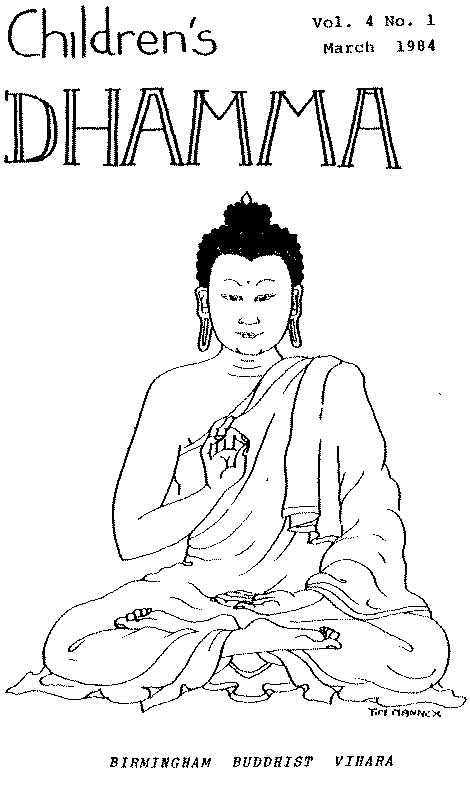Note
The following is a copy of an article – with
minor edits – that I originally posted on
Blogger.com, June 12, 2011:
https://paultrafford.blogspot.co.uk/2011/06/county-express-interview-with-fuengsin.html

The Internet and, especially, the Web are
enabling old lines of investigation to be reopened
with possibilities of new finds – for all kinds of
detectives, including biographers! In March
1981, Fuengsin was
interviewed for the County Express,
which was published, as far as I can recall, in
Stourbridge and Kidderminster. Jill Skelding was
the reporter and she came round to our house with a
photographer, Phil Loach; I can’t remember them
myself, so I expect it took place during the day
whilst I was at school. The article was part of a
series called Woman to Woman and
this particular interview was
entitled: Buddhism
as a way of life. It was published on
Friday 13th March 1981.
I thought that it would be a good time to
reproduce the article online (I don’t think the
paper is in circulation under that name any more;
it may have become Stourbridge
News). We kept a few cuttings, but even if
we had preserved them in mint condition, the
newspaper medium meant that photographic
reproduction was limited in quality. Fortunately,
Google came to the rescue (again) and 30 years
after the interview I was able to locate Phil, who
is still in the photography business
with The Silver
Image. What’s more he was able to send me a
pretty good scan (a larger version of the one
online). So the complete
article is available to view.
Here I’d just like to highlight a few things my
mother said.
It’s really quite a typical piece – finding the
mundane and profound in the everyday and the
present moment. You get a taste of something
unusual in the first two paragraphs, though it’s
definitely more mundane in flavour!
With an impressive Oriental family history
spanning several centuries and an unusual
childhood spent in Thailand, there’s nothing
Fuengsin likes better than to disappear to the
depths of her kitchen and cook … spotted dick
steamed pudding!
Mrs. Fuengsin Trafford, who lives in West
Hagley, came to England 17 years ago, in her
mid-twenties, from her home town near Bangkok.
She studied at London University – and soon found
she had a weakness for English food.
The kitchen wasn’t always frequented with such
endeavour. One of my mother’s childhood friends
said that the two of them used to play cooking. I
asked whether that was because in reality they
didn’t do any cooking and she nodded and grinned!
In fact my father taught her some of the basics
English cookery – there was little indication that
she could later produce a cookery
book! And as for her regard of the culinary
offerings of this new land, the initial response
was typically to bring out a tin of red chilli
powder … at breakfast!
There’s a brief summary of how she came to the
UK as a student, met my father, married, and
settled in the UK. When she left Thailand in the
early to mid 60s, Thonburi, where she grew up, was
still separate from Bangkok on the other side of
the Chao Phraya river and certainly was not so
developed. We spent our first family holiday there
in 1972, and there was a lot of change already by
that time, but looking at photos from that period
still shows many areas of fruit cultivation.
Fuengsin did not return next to Thailand until
after the interview, so she probably had nostalgic
recollections in mind when she recalled:
“By that time my father had died, but my
mother and Anthony got on remarkably well – the
pace of life is so different out there, it’s hard
for anyone from the Western world to understand
it immediately.”
“The pace of life in Thailand is much slower
than here in England – there just isn’t much
stress, or traffic come to think of it!”
Our next family trip was in 1988 and I think we
all found the new Bangkok somewhat
overwhelming.
The article then moves on to discuss my mother’s
Buddhist outlook, which is clearly the theme of the
photograph, which shows her in a quite serious pose
seated underneath three Buddha rupas. Fuengsin’s
characteristic directness is clearly recorded:
“Buddhism is something that has to be achieved
by the individual – but once you have reached
that point you will have enlightenment.
“It isn’t a Sundays-only type of religion, and
I know it’s hard for people who know nothing of
Buddhism to even to begin to understand what it’s
all about, but basically, no one can tell you how
to practise Buddhism, it’s something the
individual must learn for him or herself.
“It has to come from inside a person, and it
is a very personal thing – no one can help you
with it, and you can only practise Buddhism
though life itself.
“It is closely linked with meditation and when
you meditate you look at a figure of a Buddha and
bow – that way you are aiming to suppress your
ego, and get rid of any pride. Once you are rid
of that you are at one with the universe.”
She had a very practical approach to Dhamma and
these teachings are really core to the article,
including the value of service. It’s mentioned that
Fuengsin taught English to Asian immigrants – I
recall she said these were elderly Pakistani ladies
and that she was a member of a volunteer group (she
didn’t even get her bus fare paid). I’m sure my
mother would have had a quip about ‘Big
Society’!
The article concludes by switching back to food
and more steamed puddings. I think my father and I
must accept some responsibility for this – we
created quite a demand for puddings and cakes!
You are welcome to read
the interview …


